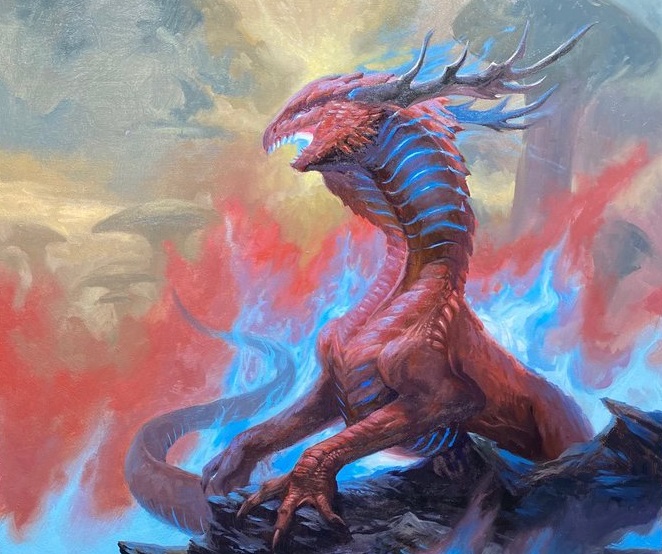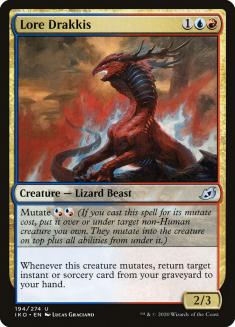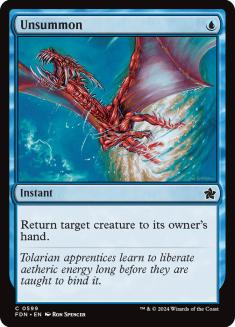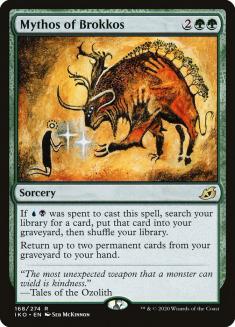I’ve been at this Magic content game for a while now, and I hope by now my readers have a sense of what I’m about. In the deep stages of a developed metagame, I try to look at macro-trends and point you towards the right existing deck to play for a given week. I leave analysis of micro-decision making and the discovery of optimal sideboard plans to my co-workers. They’re better at it than I am, and there’s no reason for me to provide a cut-rate version of what they’re immensely capable of.
Similarly, when it’s time for preview season, I’m content to take a backseat to the folks who want to tell you the best low-risk options come Week 1 of new Standard. And just to be clear, listening to those folks will likely be the right call. It’s hard to fight against established archetypes as powerful as the ones dominating Theros Beyond Death Standard, and there’s a good chance the majority of what I’ll suggest over the next few weeks will ultimately fall short.
It’s hard not to get excited about potential, though. The cards that look like they could tear a metagame in half if they get proper support will always be where I turn my attention in these early days of preview season, because if I’m correct, the reward is tremendous. Identifying the broken option before everyone else can reward you with weeks of free wins. With MagicFest Online available immediately following the release of Ikoria, the tangible benefit of the broken Week 1 deck has never been higher for the average player.
So, here’s the potentially busted card that everyone is sleeping on.
Let me begin this article by saying I think I understand how mutate works now. Articles on the mothership have offered conflicting reports and made the learning process very confusing. However, these are my current key assumptions.
- If a mutated creature returns to your hand, all creature cards that make up the mutated creature go back to you hand.
- If a targeted creature is killed in response to your attempt to mutate it, the creature with the mutate ability still enters the battlefield in its baseline state.
If either of these assumptions is false, my hype decreases significantly, but I’m slowly approaching 100% confidence. Here is the simplest version of the Lore Drakkis combo as I see it in Standard.
Of course, there are plenty of other ways to make this happen, and you don’t need your mutate creatures to be double Lore Drakkis. Each cycle of this interaction nets you any instant or sorcery from your graveyard, and your Unsummon back in your hand. If there is another creature on the battlefield that you can mutate, you can have your Unsummon back plus two additional cards.
In and of itself, I wouldn’t be all that interested in this setup. It feels very small-ball in an era of huge mana and effects. However, Lore Drakkis instantly replaces itself upon mutate resolution, assuming you’ve cast an instant or sorcery already in the game. The fail state upon death of the targeted creature is a 2/3 for two mana with a potentially useful ability later in the game. Lore Drakkis also combines favorably with many cards previewed thus far in Ikoria, most notably Sea-Dasher Octopus.
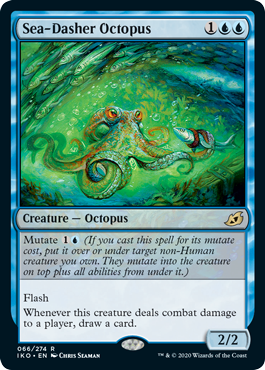
Emma Handy has lots more to say about this card in her article today, and I don’t want to steal any of her thunder. Let her explain exactly why this card is sure to be a big player in Ikoria Standard.
For our purposes, it’s enough to know it is the best mutate creature previewed thus far. It also plays beautifully with exactly the type of games that Lore Drakkis is looking to set up.
Creatures (19)
Lands (23)
Spells (18)

Not only do I think this deck is abstractly good, I also think it lines up exceptionally well against the tenets of present Standard.
- Spot removal basically doesn’t exist.
- Decks have expensive threats that immediately supercharge their strategy upon resolution.
- Most decks skip Turns 1 and 2.
If there is a nightmare matchup for this deck that presently exists, it’s probably Rakdos Sacrifice. A Priest of Forgotten Gods that beats summoning sickness is a nightmare, and any engine paired with a Mayhem Devil is likely a knockout. I’m not at the stage where I’m building sideboards yet, but some copies of Sorcerous Spyglass seem like a no-brainer. Let’s talk about what we do well, though.
This deck has reclaimed the incredible start of “one-drop into card-drawing enchantment.” The difference here is that Sea-Dasher Octopus does it better than Curious Obsession ever dreamed of. We keep the option to hold up Turn 2 Quench instead of enchanting, and that one point of differentiation might be enough to completely alter the impact Teferi, Time Raveler can have on this style of deckbuilding. It doesn’t hurt that you get your Octopus back in hand after a Teferi bounce either.
Early turns play out like an upgraded version of Mono-Blue Devotion, and that seems like a fine place to be in a world of expensive sorceries. But the real fireworks come on Turns 4 and 5. After spending countermagic early to keep your opponents off their plan, you simply spend two mana on a Lore Drakkis mutation and leave yourself with countermagic at the ready again. The addition of the cycling Neutralize means that even against a passive opponent you should have fine recursion targets.
Once you find your second Lore Drakkis, the door closes incredibly quickly. Unsummon on your pair of Drakkis lets you recast the two Drakkises, with the second copy mutating the first. Now, rebuy the Unsummon and another spell. and even if an opponent can sneak through a key permanent at this stage, you’ll be able to use Opt recursion to find a Brazen Borrower and fight on a future turn. It’s finicky, but with careful play, it’ll be very challenging for an opponent to find a foothold. All the while, you’re drawing extra cards and plinking away with your flyers. I went very light on red sources in my first build, since it should be extremely rare that you are forced into actually casting Lore Drakkis as a creature, and it is absolutely essential that all of your lands enter the battlefield untapped in this style of deck.
When it comes to our creatures, I do question whether Faerie Miscreant is going to be as good as something like Pteramander. For now, I see every bit of velocity mattering more than potential late-game sizing, especially when you start looping Unsummons. Of course, Brineborn Cutthroat would get real big, real fast here. Evasion seems far more valuable than size, though, so I’m keeping it on the bench in the first draft. I will try a bit of everything once I get to play games.
If the format moves to a place where it demands more interactivity and raw power, we have the option to shift to this two-color build.
Creatures (24)
- 4 Spectral Sailor
- 3 Bonecrusher Giant
- 4 Brazen Borrower
- 1 Illuna, Apex of Wishes
- 4 Sprite Dragon
- 4 Lore Drakkis
- 4 Sea-Dasher Octopus
Lands (24)
Spells (12)

I’m trying to juggle a lot of different paths to victory with this build. There’s still the option to ride a one-drop plus Octopus but it’s going to be far rarer. Instead, we’re looking to find some burst damage via the larger bodies of Bonecrusher Giant and Sprite Dragon while keeping the combo-centric end game we emphasized in the mono-blue build.
I still think the cycling of Neutralize is worth more than the two damage of Ionize, but that could be wrong, especially since Neutralize is going to be the harder spell to cast many times. The greatest benefits of moving to two colors are increased options in sideboarding and a deck that can still shine in spots where Quench is weak. I like mono-blue in the dark, but it doesn’t hurt to have an escape plan ready.
Creatures (17)
- 3 Spectral Sailor
- 2 Merfolk Secretkeeper
- 2 Migratory Greathorn
- 1 Brokkos, Apex of Forever
- 1 Gemrazer
- 4 Lore Drakkis
- 4 Sea-Dasher Octopus
Lands (25)
Spells (18)

Here is the wildest list I have to offer today, and it should surprise exactly nobody that I’m looking for a way to Fog my opponents to death. Yes, Questing Beast is a card. No, I haven’t seen one in months.
The setup here is basically the same as for the other decks, except instead of attempting to leverage countermagic, you’re just looking to completely lock out the combat step. There’s some tension when it comes to finding enough creatures to mutate onto in this list, because you can’t invest as many slots in evasive early creatures.
I think you need to keep some number of Spectral Sailor, because it’s too strong with Sea-Dasher Octopus, but maxing seems counterproductive to your late-game. Instead, I picked up a couple of copies of Merfolk Secretkeeper which, surprisingly, doesn’t have defender. Stockpiling the graveyard a bit should allow you to find a Root Snare with Lore Drakkis when you need to. It also makes Mythos of Brokkos a stronger card selection tool.
I’m unsure what to make of this card, but it does an excellent job setting up our combo as the game goes long and can be brought back with Lore Drakkis since it doesn’t exile itself. This allows us to convert our mutate creatures to defensive tools and get multiple uses from their triggered abilities. It’s unclear if locking out combat makes sense in a format with some other reasonable paths to victory (such as Mayhem Devil again) but you never know what the finished version of the format will look like.
Maybe I spent too long looking at Lore Drakkis today… am I crazy for thinking it could have Legacy legs?
Creatures (17)
- 2 True-Name Nemesis
- 4 Pteramander
- 2 Spectral Sailor
- 1 Brazen Borrower
- 4 Lore Drakkis
- 4 Sea-Dasher Octopus
Lands (20)
Spells (23)

It’s indisputable that recursion gets better as the power level of your cards increases. Here we don’t need to look for any long-game combo setups because a resolved Lore Drakkis on a one-drop is apt to just lock your opponent out of the game very quickly using the cards Izzet Delver routinely plays.
Lore Drakkis and free spells are a match made in heaven. Typically, you’d have nothing to rebuy after a curve of Turn 1 creature, Turn 2 Lore Drakkis mutation, but Force of Will, Force of Negation, and Daze change the math. With ample card quantity, it seems reasonable that you could have a Force of Will, Force of Negation, or Daze for every spell your opponent attempts to resolve.
Luckily, Sea-Dasher Octopus is happy to provide the juice while simultaneously allowing you to keep your mana available on your opponent’s turn. I also expect Octopus to be a respectable threat on its own in the context of Legacy, where every card drawn is so valuable and the timing of your spells is everything.
A Lore Drakkis operating at a slower pace is perfectly acceptable as well. Returning a Brainstorm or Ponder to your hand transitions you to your next threat, and possibly your next mutation or two. This drives the deck in a very graveyard focused direction, but it will be easy to shift to something like Young Pyromancer or Brazen Borrower in sideboard games.
I’ve had to make some hearty concessions to the creatures due to Delver of Secrets’s inability to mutate. There’s no question that the shift forces us to play a very different gameplan, with fewer of those free wins that classic Delver is known for. I get that it’s hard to justify totally revamping one of the oldest archetypes in Legacy. The fact that Lore Drakkis even has me trying says volumes about what the card may be capable of.
The biggest appeal to Lore Drakkis is that it does something uniquely powerful. Rules of recursion exist for a reason, and repeatable access to cards in your graveyard is just not something we see often. There is a reason exile clauses are attached to recursive effects. Without appropriate checks, it becomes possible to craft repeatable game states that are near-impossible for your opponent to overcome. Traditional countermagic, Fogs, or free countermagic – all are nightmares to play against when produced in perpetuity.
Nexus of Fate removed some very important safety features from an effect which had been a relatively benign part of Standards past, and completely warped the format. Lore Drakkis is making the same mistake.
Time to get to work.

